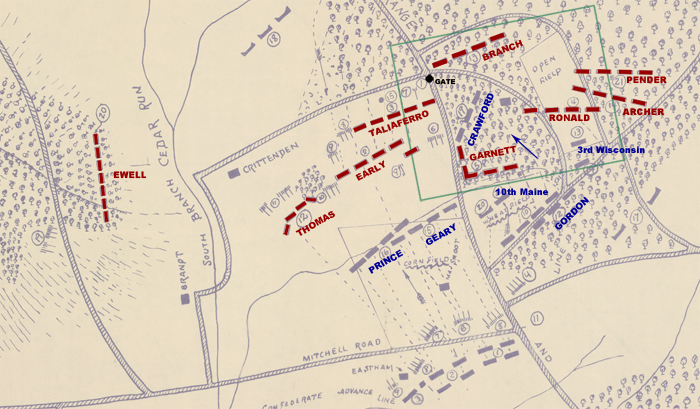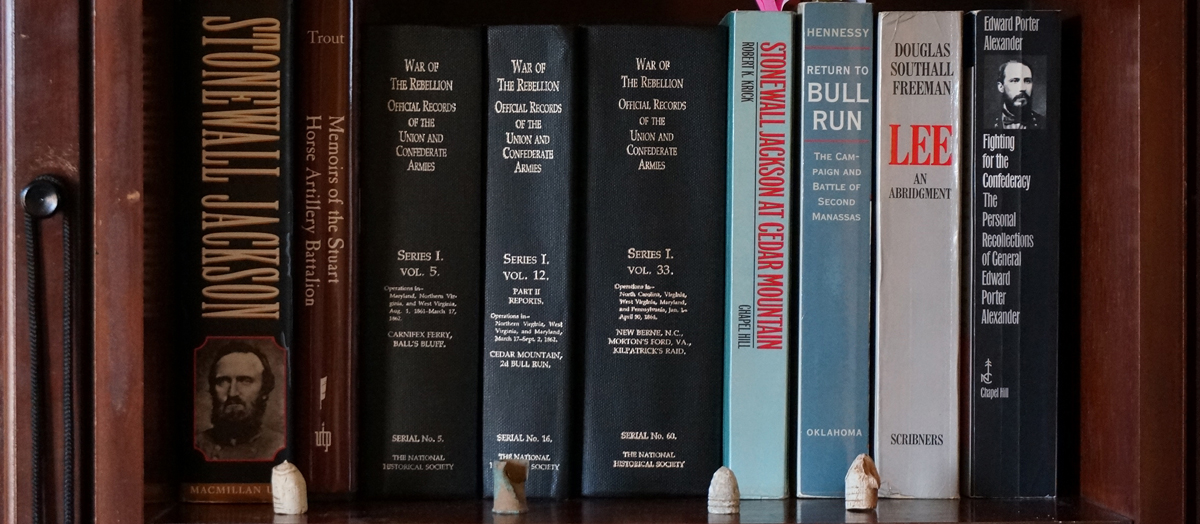Welcome to the Friends of Cedar Mountain Battlefield compilation of the Official Confederate Reports of the battle.
Introduction to the Confederate Reports of the Official Records of the War of the Rebellion for the Battle of Cedar Mountain.
Part of the mission of the Friends of Cedar Mountain Battlefield is to educate the public about events during the Civil War that took place in Culpeper County and the surrounding area; in particular the August 9, 1862 battle, known as the Battle of Cedar or Slaughter Mountain.
On the preserved portions of the battlefield, interpretive trails and guided tours help to ensure the valor of the men present in both armies on the bloodiest day in Culpeper County’s history is never forgotten. The battlefield has changed little since 1862, and walking the ground gives visitors a clear understanding of the terrain. This aids in understanding the flow of the battle. To further aid in the effort for understanding, we present here the official reports of the battle as found in “The War Of The Rebellion: A Compilation of the Official Records of the Union and Confederate Armies, Volume XII, Part II (Serial No. 16).”
Having access to the reports written in the days following the battle will enhance the visitor’s experience, as you can now stand where (for example) Garnett’s men fought, and read the account of the fight written by those who participated.
The following aggregate of the 40 Confederate reports are listed in the same order as they appear in the Official Records.
* * * * * * * * * * * *
The map pictured is intended to help with understanding the flow of the battle. The various Confederate brigades are labeled in red at their approximate positions on the field. General Ewell had two brigades on Slaughter Mountain (Trimble & Forno). The brigades of Thomas, Early, Taliaferro, and Garnett formed the initial Confederate line. The brigades of Branch, Ronald, Archer & Pender arrived in time to repulse the successful flank attack of Union General Samuel W. Crawford. The green rectangle represents (roughly) the part of the battlefield that is preserved. Click map to view larger.

Suggested Reading Order.
The reports are arranged by Division, Brigade and Regiment, which may not be the best order in which to read them. To facilitate an understanding of the flow of the battle, the following suggestions are offered. (Please note that all the individual reports cover the battle from beginning to end so there will be much overlap in the narratives.)
For an overview of the campaign, begin with the high command, Numbers 26-30.
General Richard Ewell’s Division of Jackson’s army led the march to Cedar Mountain and Jubal Early’s brigade opened the fight. Read their reports, 59 & 60 next. Major A. R.Courtney’s artillery report, No. 64, is also important to read here.
Once General Ewell secured the high ground on Reverend Phillip Slaughter’s property known as the shelf, two of his three brigades remained stationary until the final advance, so we will return to them later.
The defining event of the battle was the collapse of the Confederate left flank. The reports of all the regiments in Lieut. Col. Thomas S. Garnett’s Brigade, Numbers 37-41, detail the disaster. The Union flank attack that destroyed Garnett’s brigade continued down the Confederate line and next threatened the brigade of General William B. Taliaferro; Numbers 42-49. Report Number 45 of this range, tells how the 10th VA was ordered out of brigade line and sent to the left to aid Colonel Garnett before the flank attack began. Unfortunately they arrived just a little too late to be of much help.
It was Brigadier-General Lawrence O’Bryan Branch’s Brigade of A.P. Hill’s Division who saved the day on the Confederate left as they arrived at a critical moment to seal the breach and push back Union Brigadier-General Samuel W. Crawford’s attack force. Branch’s report is Number 55. About nearly the same time, Colonel Charles A. Ronald’s “Stonewall Brigade” arrived on the scene, to the left of Branch’s brigade. Their late but timely appearance stymied the attack of General George H. Gordon’s Brigade and began the rout of the remaining Union forces on the Confederate left.
Reports No. 31-36 are from the Stonewall Brigade. W. Dorsey Pender (No. 57) and James J. Archer’s (No. 52) brigades followed close on their heels to complete the rout of Union forces on the Confederate Left, but these reports could be read now or later.
Over on General Early’s side of the field, (the Confederate Center), in addition to Early’s report, Brigadier-General Edward Thomas’ brigade, Report No. 53, of A.P. Hill’s Division, details anchoring Early’s right and how its presence shored up for Early’s collapsing line. The report of Captain Samuel T. Player, 49th Georgia, (from the Supplemental Records) enhances Thomas’ report. Col. James A. Walker’s report, No. 61, gives some fine detail of the fight along the Crittenden Lane. Their stand checked the waning Federal flank attack. A consolidated counter-attack ensued.
The counterattack is represented in most of the Confederate reports.
Returning to General Ewell’s Division on the high ground of the Shelf, Rev. Slaughter’s property, Isaac Trimble and Henry Forno’s brigades advanced down the hill for the final Confederate advance; Reports Number 62 & Number 63. Finally, the brief dramatic artillery duel of William Pegram’s battery which closed the battle in the dark, is mentioned in Brig. Gen. Charles Fields’ report, Number 51. Lieut. Col. R. L. Walker, No. 58, also mentions Pegram’s advance at night, in addition to the part played earlier in the day with his batteries that supported General Early’s line. Leroy Stafford’s Louisiana brigade also advanced with General Field but makes no mention of Pegram’s duel.
Reading the reports in this order may bring some clarity to the battle as it unfolded, at least it is hoped so. The remaining reports will fill out further detail.
These are suggestions only.
Confederate Reports
- No. 26. — General Robert E. Lee, C. S. Army, commanding Army of Northern Virginia.
- No. 27. — Surgeon Lafayette Guild, C. S. Army, Medical Director, of the killed and wounded.
- No. 28. — Maj. Gen. Thomas J. Jackson, C. S. Army, commanding the Valley District, with congratulations from General Lee.
- No. 29. — Col. S. Crutchfield, C. S. Army, Chief of Artillery.
- No. 30. — Brig. Gen. William B. Taliaferro, C. S. Army, commanding First Division.
- No. 31. — Col. Charles A. Ronald, Fourth Virginia Infantry, commanding First Brigade.
- No. 32. — Lieut. Col. Lawson Botts, Second Virginia Infantry.
- No. 33. — Lieut. Col. R. D. Gardner, Fourth Virginia Infantry.
- No. 34. — Maj. H. J. Williams, Fifth Virginia Infantry.
- Un-numbered. — 1886 Letter of Col. H. J. Williams, (5th VA Infantry)
- No. 35. — Capt. Charles L. Haynes, Twenty-seventh Virginia Infantry.
- No. 36. — Lieut. Col. Edwin G. Lee, Thirty-third Virginia Infantry.
- No. 37. — Lieut. Col. Thomas S. Garnett, Forty-eighth Virginia Infantry, commanding Second brigade.
- No. 38. — Capt. W. A. Witcher, Twenty-first Virginia Infantry.
- No. 39. — Capt. Abner Dobyns, Forty-second Virginia Infantry.
- No. 40. — Capt. J. H. Horton, Forty-eighth Virginia Infantry.
- No. 41. — Maj. John Seddon, First Virginia Battalion.
- No. 42. — Col. Alexander G. Taliaferro, Twenty-third Virginia Infantry, commanding Third Brigade.
- No. 43. — Lieut. Col. James W. Jackson, Forty-seventh Alabama Infantry.
- No. 44. — Lieut. Col. Abner A. Hughes, Forty-eighth Alabama Infantry.
- No. 45. — Maj. Joshua Stover, Tenth Virginia Infantry.
- No. 46. — Lieut. Col. Simon T. Walton, Twenty-third Virginia Infantry.
- No. 47. — Maj — . H. C. Wood, Thirty-seventh Virginia Infantry.
- No. 48. — Lieut. J. C. Carpenter, Carpenter’s Virginia Battery.
- No. 49. — Capt. William T. Poague, Rockbridge (Va.) Artillery.
- No. 50. — Maj. Gen. Ambrose P. Hill C. S. Army, commanding Light Division.
- No. 51. — Brig. Gen. Charles W. Field, C. S. Army, commanding First Brigade.
- No. 52. — Brig. Gen. James J. Archer, C. S. Army, commanding ––––––– Brigade.
- No. 53. — Brig. Gen. Edward L. Thomas, C. S. Army, commanding Third Brigade.
- Un-numbered. — Capt. Samuel T. Player, Forty-ninth Georgia Infantry.
- No. 54. — Brig. Gen. James H. Lane, C. S. Army, commanding Fourth Brigade.
- No. 55. — Brig. Gen. L. O’B. Branch, C. S. Army, commanding ––––––– Brigade, with extracts from his journal.
- No. 56. — Col. Leroy A. Stafford, Ninth Louisiana Infantry, commanding Second Louisiana Brigade.
- No. 57. — Brig. Gen. William D. Pender, C. S. Army, commanding Sixth Brigade.
- Un-numbered. — Capt. John Ashford, Thirty-eighth North Carolina Infantry.
- No. 58. — Lieut. Col. R. L. Walker, C. S. Army, commanding artillery battalion, Light Division.
- No. 59. — Maj. Gen. Richard S. Ewell, C. S. Army, commanding Third Division.
- No. 60. — Brig. Gen. Jubal A. Early, C. S. Army, commanding Fourth Brigade.
- No. 61. — Col. James A. Walker, Thirteenth Virginia Infantry.
- Un-numbered. — Maj. John Kasey, Fifty-eighth Virginia Infantry.
- No. 62. — Brig. Gen. Isaac R. Trimble, C. S. Army, commanding Seventh Brigade.
- No. 63. — Col. Henry Forno, Fifth Louisiana Infantry, commanding Hays’ (or First Louisiana) brigade.
- No. 64. — Maj. A. R. Courtney, C. S. Army, Chief of Artillery, Third Division.
- Un-numbered. —Lt. Nathaniel Terry, Bedford Artillery.
- No. 65. — Capt. Louis D’Aquin, Louisiana Guard Artillery.
- No. 66. — Col. William E. Jones, Seventh Virginia Cavalry.

